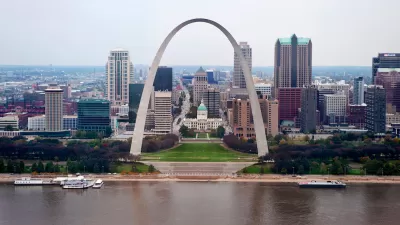St. Louis provides the backdrop for a discussion about "middle neighborhoods"—the subject of a 2016 book by Paul C. Brophy.

"There are neighborhoods in St. Louis that are thriving and those that are very much struggling, but what about neighborhoods that fall somewhere in the middle?"
That's the question posed by an article by Kelly Moffitt to summarize a recent episode of St. Louis on the Air. The episode featured Alan Mallach, Henry Webber, and Reginald Scott, who discussed the idea of "middle neighborhoods, as examined in a recent research study titled "One the Edge: America's Middle Neighborhoods." The study was edited by Paul C. Brophy, and originally published by the Federal Reserve Bank of San Francisco. Now, however, the study is available in book form.
According to Moffitt's coverage of the study and its examples from the city of St. Louis, middle neighborhoods are threatened by a shrinking middle class. "Middle neighborhoods could fall into distress (areas with high poverty and declining real estate values) or they could turn into thriving neighborhoods … but that takes policy heft," writes Moffitt.
Such policy strategies include locating jobs nearby the neighborhood and identifying amenities in the neighborhood that can attract new residents.
FULL STORY: What are St. Louis’ ‘middle neighborhoods’ and how can they be stopped from falling into distress?

Study: Maui’s Plan to Convert Vacation Rentals to Long-Term Housing Could Cause Nearly $1 Billion Economic Loss
The plan would reduce visitor accommodation by 25,% resulting in 1,900 jobs lost.

North Texas Transit Leaders Tout Benefits of TOD for Growing Region
At a summit focused on transit-oriented development, policymakers discussed how North Texas’ expanded light rail system can serve as a tool for economic growth.

Why Should We Subsidize Public Transportation?
Many public transit agencies face financial stress due to rising costs, declining fare revenue, and declining subsidies. Transit advocates must provide a strong business case for increasing public transit funding.

How to Make US Trains Faster
Changes to boarding platforms and a switch to electric trains could improve U.S. passenger rail service without the added cost of high-speed rail.

Columbia’s Revitalized ‘Loop’ Is a Hub for Local Entrepreneurs
A focus on small businesses is helping a commercial corridor in Columbia, Missouri thrive.

Invasive Insect Threatens Minnesota’s Ash Forests
The Emerald Ash Borer is a rapidly spreading invasive pest threatening Minnesota’s ash trees, and homeowners are encouraged to plant diverse replacement species, avoid moving ash firewood, and monitor for signs of infestation.
Urban Design for Planners 1: Software Tools
This six-course series explores essential urban design concepts using open source software and equips planners with the tools they need to participate fully in the urban design process.
Planning for Universal Design
Learn the tools for implementing Universal Design in planning regulations.
City of Santa Clarita
Ascent Environmental
Institute for Housing and Urban Development Studies (IHS)
City of Grandview
Harvard GSD Executive Education
Toledo-Lucas County Plan Commissions
Salt Lake City
NYU Wagner Graduate School of Public Service





























